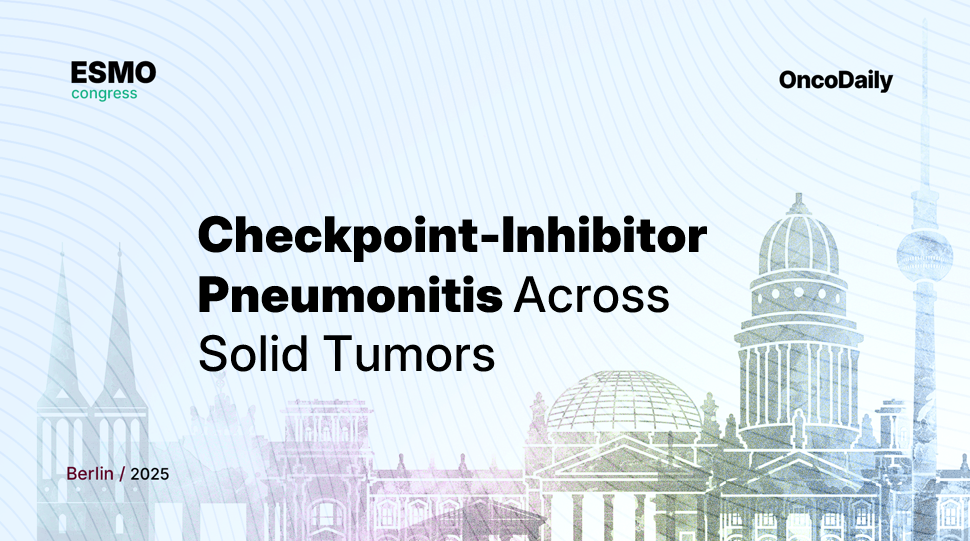Fresh from the podium at the ESMO Congress 2025, new findings were presented from the prospective pooled analysis to date evaluating checkpoint-inhibitor pneumonitis (CIP) across 25 global Phase III trials of nivolumab, alone or in combination with ipilimumab and/or chemotherapy, spanning nine solid tumor types. This comprehensive investigation sought to clarify the natural history, risk factors, and management patterns of CIP, a rare but potentially fatal immune-related adverse event associated with immune checkpoint inhibitors (ICIs).

Cheackpoint inhibitor pneumonitis
Background
Checkpoint-inhibitor pneumonitis (CIP) is an uncommon but potentially life-threatening immune-related adverse event (irAE) associated with PD-1 and CTLA-4 blockade. Despite the widespread adoption of immune checkpoint inhibitors across oncology, the natural history, recurrence patterns, and long-term outcomes of CIP remain poorly defined.
Given the increasing use of combination immunotherapy regimens, particularly nivolumab plus ipilimumab, understanding the clinical characteristics and management of CIP has become crucial for oncologists. This pooled analysis integrated safety data from 25 Phase III global clinical trials, encompassing over 11,700 patients treated with nivolumab-based regimens across major solid tumor types, to provide the most detailed overview of CIP incidence and outcomes to date.
Methods
Data from 11,777 patients enrolled across 25 Phase III trials involving nivolumab ± ipilimumab ± chemotherapy or other agents were pooled for analysis. The cohort included patients with non-small cell lung cancer (NSCLC, n=3654), gastroesophageal cancer (n=2276), melanoma (n=1910), and renal cell carcinoma (RCC, n=1323), among others.
Key endpoints included CIP incidence, severity (CTCAE grades 1–5), time to onset and resolution, management strategies (use of corticosteroids [CS] and other immunosuppression [OIS]), and clinical outcomes. Investigators also identified cases of chronic CIP (lasting ≥12 weeks) and recurrent CIP, as well as regional variations in management practices.
Results
Among the 11,777 patients analyzed, 716 developed CIP (6.1%). The incidence of CIP was:
- Higher in men (6.6%) than women (4.9%)
- Increased with age, reaching 8.5% in patients over 75
- Most frequent in patients treated with nivolumab + ipilimumab (8.0%), followed by nivolumab + chemotherapy (6.4%) and nivolumab monotherapy (4.6%)
- Most common in NSCLC (40% of all CIP cases)
Severity and Outcomes:
- Grade distribution: G1 (22.7%), G2 (45.7%), G3 (27.1%), G4 (4.1%), G5 (0.4%)
- 70% of all cases resolved, while 4% were fatal
- Median time to onset: 17 weeks (range 0.3–123.6)
- Median time to resolution: 9 weeks (range 0.1–143)
Chronic and Recurrent CIP:
- Chronic CIP occurred in 34.6% of patients (n=248)
- Recurrent CIP in 8.5% (n=61), most commonly in RCC (17.6%) and hepatocellular carcinoma (13.3%)
- Median time from initial to recurrent event: 6.1 weeks
Management:
- Corticosteroids (CS) were used in 74% of all CIP cases and in 90% of grade ≥3 cases
- Other immunosuppressants (OIS) were rarely required (3.4% overall; 8.4% for grade ≥3)
- Regional differences were observed in CS use for grade 1 CIP: Asia (8%), Europe (27%), North America (20%)
Notably, grade 1 CIP outcomes were similar regardless of CS use, and progression occurred in roughly one-third of patients even with corticosteroid treatment.
Conclusions
This large-scale pooled analysis offers the most comprehensive characterization of checkpoint-inhibitor pneumonitis across multiple tumor types and treatment regimens. CIP was found to be more frequent in older patients, men, those receiving combination nivolumab–ipilimumab therapy, and in NSCLC. Importantly, approximately one-third of cases became chronic and nearly 9% were recurrent, emphasizing the need for prolonged monitoring and improved management strategies.
The findings also highlight significant geographic variability in corticosteroid use and underscore that low-grade (grade 1) CIP can progress regardless of steroid treatment. Together, these insights advance the understanding of CIP’s natural history and may inform future clinical guidelines for the diagnosis, management, and surveillance of this serious immune-related toxicity.
You can read the full abstract here.
